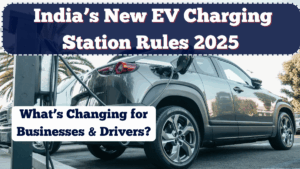The EV Charging Station Norms India 2025 have officially been implemented, revolutionizing the landscape for electric vehicle users and infrastructure developers across the country. As part of the government’s ambitious sustainability push, the Power Ministry has introduced key revisions to ensure seamless, safe, and accessible charging for all.
This new framework supports India’s growing electric vehicle ecosystem, while addressing the practical challenges faced by drivers and station owners. From charger types to station layout, the EV charging norms 2025 provide uniformity, safety compliance, and scalability.
With these reforms in place, both private EV users and commercial fleet operators will now experience smoother, standardized services nationwide.

What Are the Major Updates in the 2025 Charging Norms?
The Power Ministry has introduced a range of regulatory improvements that all public and private charging stations must follow. These include:
-
Mandatory 24/7 access for all public charging stations in metropolitan cities.
-
Minimum two charger types (Type 2 AC and CCS2 DC) per station.
-
Real-time availability integration with national e-mobility apps.
-
Installation approval window reduced to just 15 working days.
-
Tariff standardization – Separate rates for domestic, commercial, and fleet charging.
These measures under the EV Charging Station Norms India 2025 will increase confidence among vehicle owners and accelerate the country’s e-mobility mission.
What Businesses Need to Know About the Power Update India
Businesses planning to set up EV charging stations now have clearer rules and incentives to expand their services. Key takeaways from the power update India include:
| Business Norm | Requirement |
|---|---|
| Minimum Area | 100 sq. meters for urban stations |
| Grid Connection | Must comply with DISCOM fast-track process |
| Billing System | Smart meter with dynamic tariff |
| Safety Measures | Fire extinguisher, CCTV, and circuit breakers |
Small entrepreneurs, malls, hotels, and fleet depots can benefit from subsidies of up to 25% on infrastructure costs under the new scheme.
How It Helps EV Drivers and Daily Commuters
Drivers will now see immediate benefits from the EV charging norms 2025, such as:
-
More charging options in rural and tier-2 towns.
-
Real-time location of nearby charging points through mobile apps.
-
Less queue time at stations due to mandatory dual charging ports.
-
Consistent pricing and digital payment options.
These changes aim to make EVs as convenient to refuel as petrol or diesel vehicles, especially during long-distance travel or daily urban commuting.
States Leading the Way in EV Infrastructure
Several Indian states are implementing the EV Charging Station Norms India 2025 more aggressively than others:
-
Delhi & Maharashtra: Smart charging hubs with integrated parking.
-
Tamil Nadu: EV corridors on major highways.
-
Gujarat & Karnataka: Industrial EV fleet support and solar-powered stations.
The power update India also allows states to set additional guidelines for station density, urban zoning, and integration with renewable energy sources.
FAQs
What are the EV Charging Station Norms India 2025?
They are updated guidelines released by the Power Ministry that standardize installation, operation, and accessibility of electric vehicle charging stations across India.
Who can set up a charging station under the new norms?
Any individual, business, or entity with land access and power supply can apply through the DISCOM’s fast-track portal to set up an EV charging station.
What types of chargers must be installed?
As per the EV charging norms 2025, every station must include at least one Type 2 AC and one CCS2 DC charger to support both slow and fast charging.
Are these norms mandatory for private home chargers?
No. These norms apply to public and commercial EV stations. However, home chargers must follow basic electrical safety standards.
Is there any subsidy available for installing EV stations?
Yes. The power update India initiative offers up to 25% subsidy for eligible businesses and entrepreneurs, especially in underserved areas.
Click here to know more.
